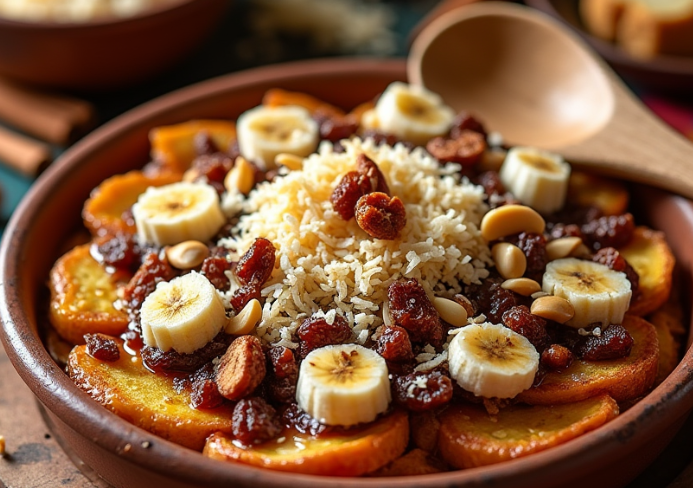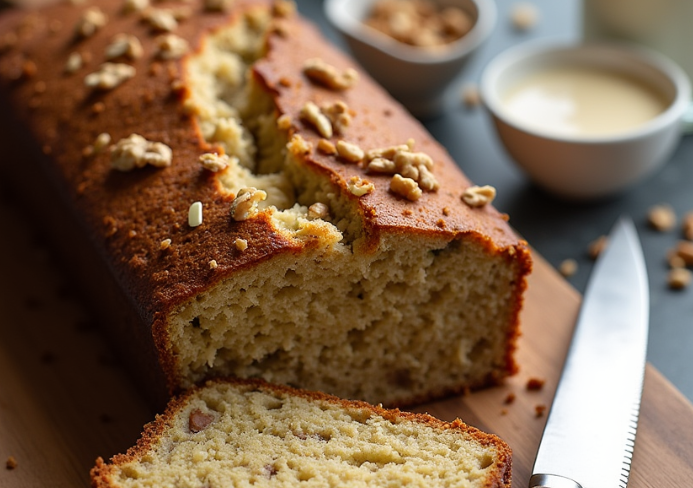Recetas de cocina | CAPIROTADA MEXICANA TRADICIONAL
The capirotada mexicana tradicional is much more than a delicious dessert—it’s a culinary relic with centuries of history, deep religious meaning, and rich regional diversity. This traditional Mexican bread pudding, typically prepared during Lent (Cuaresma), brings families together around a dish that beautifully balances sweet, salty, and spicy flavors.
Every layer of this humble yet flavorful dish tells a story. It’s not only one of the most iconic recetas de cocina mexicanas, but also a cultural touchstone. Today, we’ll explore its origins, symbolic ingredients, variations, preparation method, and everything you need to recreate this timeless favorite at home.
Table of Contents
What Is Capirotada?
Capirotada is a traditional Mexican dessert resembling bread pudding, typically made with layers of toasted or fried bolillo bread, soaked in a syrup made from piloncillo, canela, and clavo. It’s then layered with ingredients like pasas, cacahuates, queso cotija, and baked until the flavors meld together into a warm, comforting dish.
This dish has strong religious roots and is usually served during Lent, especially on Viernes Santo. In fact, it’s not uncommon to find this dessert prepared in households that also observe fasting traditions during Holy Week.
Beyond being delicious, capirotada is filled with symbolism tied to the Passion of Christ. Each ingredient has a deeper meaning. According to U.S. Catholic, the bread represents the body of Christ, the syrup his blood, cinnamon sticks the wooden cross, and cloves the nails. Even the melted cheese is said to represent the Holy Shroud.
To better understand how capirotada fits into the broader context of Mexican food traditions, it’s worth exploring the history of Mexican cuisine and how Spanish, Moorish, and Indigenous influences shaped this beloved dish.
Origins and Historical Significance
Capirotada originated from Spain, influenced heavily by Moorish cuisine, and was introduced to Mexico during colonial times. Initially, it was a savory dish meant to use up stale bread. Over time, Mexican cooks transformed it into a sweet, comforting dessert, adapting it with local ingredients like piloncillo, tropical fruits, and native nuts.
The evolution of capirotada reflects the blending of European and Indigenous culinary traditions—a hallmark of Mexican gastronomy. Today, it’s one of the few dishes that has maintained both its colonial and pre-Hispanic roots.
Regional Variations Across Mexico
Each region in Mexico adds its own twist to the traditional capirotada recipe:
- Northern Mexico: Often uses toasted tortillas or includes cheddar cheese and pecans.
- Michoacán: Adds chocolate chips, fried plantains, and guava.
- Sonora and Sinaloa: Include onions, tomatoes, and anise seed in the syrup for a savory-sweet balance.
- Central Mexico: Stays closest to the traditional version with bolillo, piloncillo, clavo, and queso cotija.
Religious Symbolism of the Ingredients
Each main component in capirotada carries religious significance tied to Christian tradition:
- Bread: Body of Christ
- Piloncillo syrup: Blood of Christ
- Cinnamon sticks: The cross
- Cloves: The nails
- Melted cheese: The burial shroud
This symbolic structure is why capirotada is more than food—it’s a form of devotion.
Ingredients and Recommended Substitutions
Here are the traditional ingredients and some modern alternatives:
Main Ingredients:
- Bolillo (or French bread, preferably stale)
- Piloncillo (or dark brown sugar)
- Clavos de olor
- Canela en rama
- Pasas (raisins)
- Cacahuates (roasted peanuts)
- Queso Cotija (can be swapped with mild cheddar or parmesan)
- Coco rallado (optional)
- Mantequilla y aceite vegetal
Optional Toppings:
- Plátano frito (fried banana)
- Sprinkles (for festive presentation)
- Nueces, almendras, piñones, or nueces de la India

Nutritional Value and Health Notes
Though delicious, capirotada is rich in carbohydrates and sugars due to piloncillo and dried fruits. A typical serving can exceed 400–600 calories, but it offers nutritional minerals from nuts and the piloncillo. The dish is best enjoyed in moderation as part of a balanced meal.
Step-by-Step Recipe for Capirotada Mexicana Tradicional
Follow these steps to make a delicious traditional capirotada:
1. Make the syrup (jarabe):
- Boil 1.5 cups of water, 1 cinnamon stick, 2 cloves, and 12 oz of piloncillo until completely dissolved.
- Simmer for 10 minutes, then remove the cinnamon and cloves.
2. Toast or fry the bread:
- Slice bolillo into 1/3″ thick pieces.
- Mix butter and oil, brush on each side, and bake until golden brown (or fry for a richer flavor).
3. Layer the ingredients:
- In a deep baking dish, layer bread slices.
- Add raisins, nuts, coconut, and sprinkle cheese between each layer.
- Slowly ladle the syrup over each layer to ensure even absorption.
4. Final touches and bake:
- Top with more queso cotija and butter cubes.
- Cover with foil and bake at 350°F (180°C) for 45 minutes.
5. Serve:
- Serve warm or at room temperature.
- Perfect with café de olla or leche evaporada.
Cooking Tips & Substitutions
To get the best flavor and texture:
- Soak raisins in warm water or rum for extra plumpness.
- Try challah or Italian bread if bolillo isn’t available.
- Add anise seed or banana slices for regional flavor profiles.
- For a crispy top, remove foil in the last 10 minutes of baking.
Serving Suggestions
- Best served slightly warm
- Garnish with fresh fruit or a dusting of cinnamon
- Pairs well with traditional drinks like atole or Mexican hot chocolate
Storage and Shelf Life
- Can be stored in the refrigerator for 1–2 days
- Avoid freezing to prevent sogginess
- Best texture within 24 hours of baking
Frequently Asked Questions (FAQs)
What is capirotada made of?
Capirotada is made from stale bread, piloncillo syrup, raisins, nuts, and cheese. Other ingredients like coconut, banana, or sprinkles are optional.
Is capirotada served hot or cold?
Traditionally served warm, but some enjoy it at room temperature. It’s rarely served cold from the fridge.
Can I make capirotada without cheese?
Yes! While cheese adds a savory balance, it’s optional. Many regional versions omit cheese altogether.
Can I make it ahead of time?
Yes, but assemble it just before baking. Otherwise, the bread may become too soggy.
What bread works best for capirotada?
Bolillo is traditional, but French bread, Italian loaf, or challah are excellent substitutes.
How is capirotada different from American bread pudding?
Unlike bread pudding, capirotada uses a piloncillo-based syrup, has savory touches (cheese), and carries religious symbolism.
Conclusion
Capirotada mexicana tradicional is a culinary experience steeped in Mexican culture, Christian tradition, and flavorful heritage. Whether you make it for Lent, a special family gathering, or just to connect with your roots, it’s a dish that warms hearts and homes.
If you’re exploring other Lenten-friendly dishes, check out this guide on how to prepare nopales for a nutritious and traditional side.
Let the layers of syrup-soaked bread, sweet raisins, crunchy peanuts, and salty cheese take you on a journey through history, flavor, and devotion—one bite at a time.
PrintRecetas de cocina | CAPIROTADA MEXICANA TRADICIONAL
- Total Time: 1 hora 5 minutos
- Yield: 6 a 8 porciones
Description
La capirotada mexicana es un postre tradicional de Cuaresma que combina capas de pan tostado o frito, pasas, cacahuates, queso Cotija y un jarabe aromático de piloncillo con canela y clavo. Esta versión clásica permite variaciones modernas como coco, nueces o plátano frito.
Ingredients
- 1 bolillo grande (o pan francés) rebanado y ligeramente duro
- 12 oz (aprox. 1½ tazas) de piloncillo rallado
- 1 rama de canela
- 2 clavos de olor
- 1½ tazas de agua
- ½ taza de pasas
- ½ taza de cacahuates tostados
- ¾ taza de queso Cotija rallado (o sustituir por cheddar suave o parmesano)
- ¼ taza de coco rallado (opcional)
- 2 cucharadas de mantequilla
- 2 cucharadas de aceite vegetal
- Opcionales para decorar: plátano frito, chispas de colores, nueces, almendras, piñones, nueces de la India
Instructions
- Preparar el jarabe: En una cacerola, hierve 1½ tazas de agua con la canela, los clavos y el piloncillo hasta que se disuelva por completo. Cocina a fuego lento 10 minutos. Retira los clavos y la canela.
- Tostar o freír el pan: Corta el pan en rebanadas de 1 cm. Unta con una mezcla de mantequilla y aceite y hornea a 180°C (350°F) hasta que esté dorado, o fríe para una versión más tradicional.
- Montar las capas: En una fuente para hornear, coloca una capa de pan, luego agrega pasas, cacahuates, coco rallado y queso. Repite capas hasta terminar los ingredientes, bañando cada una con jarabe caliente.
- Hornear: Agrega cubos de mantequilla por encima y más queso. Cubre con papel aluminio y hornea a 180°C (350°F) por 45 minutos.
- Servir: Deja reposar al menos 10 minutos antes de servir. Se puede disfrutar tibia o a temperatura ambiente. Ideal con café de olla o leche evaporada.
Notes
Para una versión más rica, añade plátano frito entre las capas. Puedes sustituir el piloncillo por azúcar moreno si es necesario. El pan debe estar seco o tostado para que absorba bien el jarabe sin deshacerse.
- Prep Time: 20 minutos
- Cook Time: 45 minutos
- Category: Postre tradicional
- Method: Horneado
- Cuisine: Mexicana







